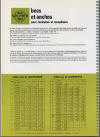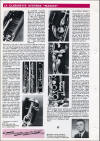Visit me on YouTube at
Visit us on YouTube Clarinet Perfection on YouTube
or email at
gottalovetheknowledge@gmail.com
Early Years Selmer 55
BT / Balanced Tone CT / Centered
Tone CT versus Series 9
Series 9 Marchi
10G 10S II
Recital
Professional clarinets since 1885 The Series: is the letter in the serial number itself and not the model
Series.
Example: Selmer, Series 10S, #B0478 is a B Series made in 1980.
We have no information on Selmer clarinets made before the L Series
Selmer Paris clarinets in various years through the 1980s had markings
similar to “Sole Agents, US & Can Selmer New York – Elkhart”.
Clarinets with markings similar to these can be identified as clarinets exported
to the United States. European and Canadian Selmer clarinets had no
markings.
old Selmer Paris PDF on the Factory
A fantastic writeup on the beginning of Selmer Paris from Don Makrill
http://www.donmack.com/pages/the-selmer-paris-story
The Bb Boehm system clarinet was first introduced in the Selmer
catalogue in 1910
per the
Selmer “Clarinets: The essentials” (click here) catalog circa 2010.
Click here for more detailed information below
| Harmony and Metal clarinets were serialized separately until at least 1930. By the N series all their instruments are serialed together. Later Metal clarinets had and adjustable barrel with a highly grooved section, earlier models where not adjustable. |
|||
| Date | Soprano | Harmony | Metal |
| 1/1/19 (14) | 1000 | ||
| 1/1/20 (15) | 2000 | ||
| 1/1/21 (16) | 3000 | ||
| 1/1/22 (17) | 4000 | 300 | |
| 1/1/23 (18) | 5000 | (300) | |
| 1/1/24 (19) | 6000 Old Emblem 65xx |
||
| 1/1/25 (20) | 7000 | ||
| 1/1/26 (21) | 8000 | ||
| 1/1/27 (22) | 9000 | 1000 | |
| 1/1/28 (23) | K1000 | ||
| 1/1/29 (24) | K2000 | 2000 | |
| 1/1/30 (25) | K3500 (K3000) | ||
| 1/1/31 (26) | K5000 (K4200) | ||
| 1/1/27 | K5600 | ||
| 1/1/28 | K7000 | 1000 | |
| 1/1/29 | K8400 | sn1906 courtesy of Junkdude.com Pic # 1 Pic # 2 Pic # 3 Pic # 4 Pic # 6 Pic # 7 |
|
| 1/1/30 | K9800 | 900 | 2000 |
| 1/1/31 | L1000 | Later Metal clarinets had an adjustable barrel with a highly grooved section, earlier models where not adjustable. –> |
Bb 23xx & A 29xx with adjustable barrel Pic # 1 Pic # 2 Pic # 3 Pic # 4 Pic # 5 |
| 1/1/32 | L2100 | 3000 | |
| 1/1/33 | L3250 | ||
| 1/1/34 | L4300 | 4000 | |
| 1/1/35 | L5500 | ||
| 1/1/36 | L6600 | 5000 | |
RI – Radio Improved started around K7000
BT – Balanced Tone started around L5000
The modern Selmer emblem starts in 1926, somewhere around K4500. There
was also an earlier emblem, up to somewhere in the 4000’s, that has a
winged globe over the H SELMER A PARIS oval. I have heard that the
winged-globe emblem indicates the era when Henri Selmer himself still
tested and finished the clarinets but that’s purely anecdotal, there’s no
reason to assume it’s true, but he was primarily a clarinet player and i’m sure
he tested many of the clarinets produced in his factory – why not?
Wouldn’t you !!
The RI model begins around K7000, the BT around L5000. The articulated
G# was not particular to the M-series, it appears in some horns of every
model up to even the 10S.
K Foster
| Year of make | Serial number | Emblems (click on pic to see larger view) |
| 1885 to 1926
1904 – clarinet launched at the Saint Louis / |
no records   1910 Catalog – click the pictures for full screen 1910 Catalog – click the pictures for full screen     |
            |
| 1/1/1927 | #400
1928 Ads – click on picture for full screen |
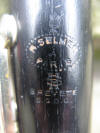 150x 150x Pic1 Pic2 Pic3 Pic4 Pic5 Pic6 |
| 1/1/1929 | #3070 | _small.jpg) sn#531x |
| 1/1/1931 | #9999 | |
| Emblem change. The old emblem, pictured right was similar to the Buffet Logo in that H. Selmer is on the top arch, Paris on the lower arch both in an oval. And an emblem of HS is below the oval similar to the BC for Buffet-Crampon. Also above is a music lyre |
 |
|
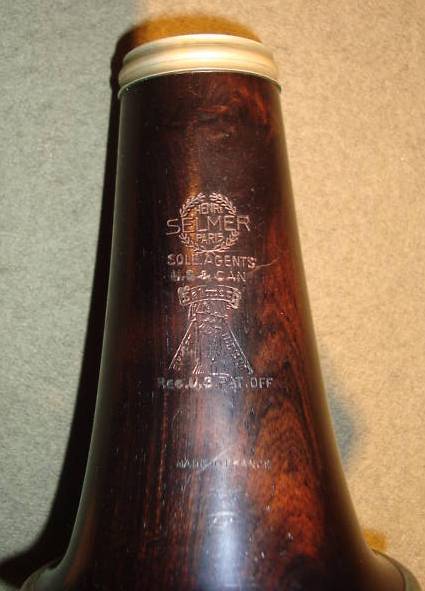 |
The import/bell emblem was also changed as below in the K series. The two bells here show that the US Import stamp was done separately from the Selmer logo as they are both in different positions – notice the space or lack thereof from the Selmer Paris wreath logo between the two. 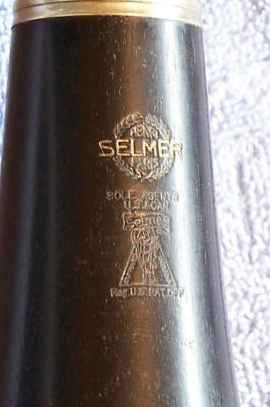 |
|
| L Series: | Old Selmer Emblem is Buffet-like (many makers had Buffet-like emblems)
|
|
| 12/1/1931 | L1000 | |
| 1932 | L2100 | |
| 1933 | L3250 | 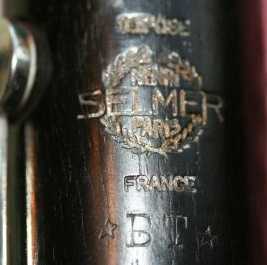 |
| 1934 | L4300 | |
| 1935 | L5500 Manufacturing Pic – click for full page         |
|
| 1936 | L6600
Catalog Pictures – click on each page for full |
|
| 1937 | L7750 | |
| 1938 |
L8800 |
|
| 1939 | L9900 | |
| M Series | ||
| 2/1/39 | M1000 | |
| 1940 |
M2400 |
|
| 1944 | M3400 | |
| 1945
Selmer 55 1945 only (?) |
M6000 Emblem of sn # M70xx |
  |
 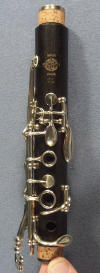   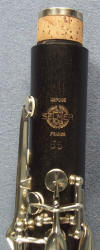 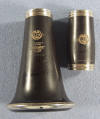  |
||
| 1946 | M8000 | |
| N Series – Later N series were also known as BT – Balanced Tone – both identifiable by a large domed speaker bush (the body octave hole) with two holes to remove it, and a removeable speaker tube. |
||
| 10/1/46 | N100 | |
| 2/1/47 | N1000 | |
| 1948 | N2800 | |
| 1949 | N4900 | Enhanced Boehm N54xx |
| 1950 | N6600 | |
| 1951 | N8100 | |
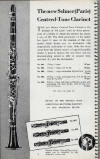 P Series – Centered Tone series – identifiable by a large hexagonal speaker P Series – Centered Tone series – identifiable by a large hexagonal speakerbush (the body octave hole). Benny Goodman made these instruments famous. The Centered Tone bore changed through the years. Initially it was a cylindrical bore of 15.00mm to 15.10mm. The barrel was 66mm long and had a slightly wider 15.15 bore.After the Q series the bore changed and continued on through the Series 9. The Q series brought along the change of longer upper and lower joints of approximately 5mm. If you click on the brochure for a full page view you will notice the options you had with these clarinets. And another interesting note – the mouthpiece in the picture is a lower emblem mouthpiece – not the oval table (which has a middle body crest emblem – see the Mouthpiece gallery for pictures of these). So .. one would assume the Ovals came AFTER the introduction of the CTs. 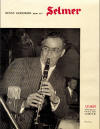 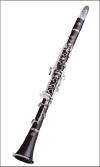 Selmer Centered ToneI’ve had the opportunity to play and setup a nice Selmer Centered Tone “A”, and respectifully compare it to my Bb variant. The Centered Tone clarinets were pinnacle of Selmer’s “Jazz” clarinet. Not that it is a jazz clarinet only, as I believe the entire clarinet section in the Boston Symphony also used them back in the day, but Benny Goodman was used extensively in marketing/sales of this clarinet. And Benny Goodman is known as a jazz player, thus the CT was known as a jazz clarinet.But there are two versions of the CT. Earlier versions had a cylindrical upper joint, where as later versions had a tapered upper joint which continued on with the Series 9 model.One can go here for pictures and a quick comparison of a late CT and an early Serie 9 by clicking hereFor me, a tapered instrument provides a bit more balance by providing a more consistent backpressure through the entire instrument especially with this “large bore” clarinet. With cylindrical clarinets I feel as though the resistance lessens as one plays down the instrument. With the tapered bore it becomes more consistent and controlled.The CT also has large toneholes. The large bore and large toneholes allows the player to blow as much as they want with the mouthpiece reed combination really being the point of resistance. In other words, if you need to be as loud as possible, the CT was the clarinet to have especially if you don’t have a mic. But of course, on the other end of the spectrum one is able to control the instrument to the finest pianissimos. My CT I actually overblew once in a (practice) concert setting above the trumpets right behind me trying to make sure we were balanced … oops.Tonally the CTs are fantastic. Full sounding, and a full deep woody tone. Not as deep sounding as say an Artys but pretty good. The upper register sings clear all the way through altissimo. The large toneholes don’t restrict the tone at all and all notes become clear from top to bottom. Now if one really likes big bore clarinets then one would really like the “A” LIKES: A real jazz clarinet, the “A” a great combination of flexibility and Standard Boehm CTs normally had nickel plated keywork. |
||
| 1952 | P1200 | P1549 – Enhanced Boehm |
 |
||
| 1953 | P4200 | |
| 1954 | P7400 | |
| Q Series: | ||
| 1955 | Q1100 | |
| 1956 | Q4350 | |
| 1957 | Q7290 | |
| R Series: |  |
|
| 1958 | R1200 | CT R series. Upper joint top bore of 15.23 and lower bore of 14.85. So later CTs are Series 9 bores. On series 9s you can also see the large octave nut similar to the CTs. |
| 1959 – Mazzeo system (more information) |
R6100 | Selmer Mazzeo Clarinet Article Mazzeo Brochure #1 Mazzeo Brochure #2 |
|
(click on each small In the below pictures you can see some of the keywork differences between CT (Centered Tome) on top, 9 (Seriese 9) on bottom. Same entry/exit bores but the 9 is longer You You P P |
||
| S Series – 1960 – Series 9 started production (large diameter tone holes with no undercutting) and 9* |
||
| 1960 | S1150  |
Selmer 9* emblem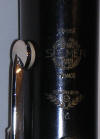 |
| 1961 | S4160 | |
| 1962 | S7390 | |
| T Series: | ||
| 1963 |
T1400 |
|
| 1964 | T5800 | |
| U Series: | ||
| 1965 | U1100 | |
| 1966 | U5700 | |
| V Series: | Selmer made some refinements to improve intonation. | |
| 1967 | V1000 | |
| 1968 | V4800 | 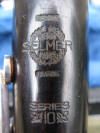 v789x Series 10 Bb – Bb & A |
| 1969 | V7900 |
v822x Series 10 A |
| W Series: | ||
| 1970 | W1700 | |
| 1971 – Series 10 is launched (per Selmer) | W5900  |
|
| X Series: | ||
| 1972 | X1500 | |
| 1973 | X6400 | |
| Y Series: | ||
| 1974 | Y1200 | |
| 1975 | Y6300
The Marchi mechanism Clarinet – really interesting. |
|
| Selmer 10G Clarinet | 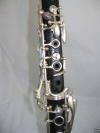 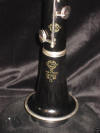  |
|
| Z Series: | ||
| 1976 | Z1100 | |
| 1977 – model 10 SII is launched | Z5200 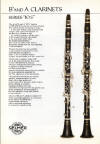 |
|
Selmer 10G
|
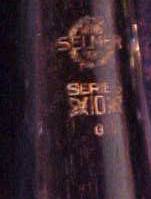 |
|
| A Series: | ||
| 1978 | A1000 | |
| B Series: | ||
| 1980 & 1981 | ||
| 1984 – Recital series launches | Selmer A clarinet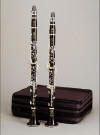 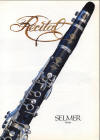 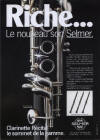 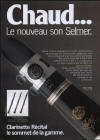     |
   |
| Signature | SELMER SIGNATURE Recently I had the opportunity to setup a set of Selmer Signature clarinets, both the Bb and A version of these instruments. They both had wonderful accoustics and playing capabilities. Their projection seems wonderful, and the overall balance from top to the bottom of the clarinet was very smooth and very tonally centered.The Selmer Signatures are a specially designed clarinet. All the toneholes are raised to increase the total length of each tonehole. The barrel, to a lot of modern Selmers have a smaller bore than the upperjoint. This barrel seems to provide a level of centered and resistance to make the clarinet a very balanced instrument preventing the player from “overblowing” in a sense. Though to someone like myself that prefers excessive dynamics, ie being able to go from not only very soft pianissimmos but to loud but balanced fortissimmos, the Signature is a bit too reserved to my liking. This in no way means there is a problem with the clarinet in any regards but that it is more of a symphonic or chamber players clarinet.For me, I really enjoy my Leblanc LLs for chamber music as it can mix very well tonally with other select woodwinds and string instruments but then I don’t play them often for the same reason.Other players have commented that the Signatures are “stuffy”. But I like the term “reserved”. If one prefers a high airflow and/or larger tip mouthpieces they will feel held back by these instruments, or in their term, it seems “stuffy”. But in all other scenarios, such as small ensemble playing this instrument is fantastic. This is in no means saying one cannot use it for any setting, but with so many other great clarinets out there this one seems to fit into only certain categories for me.Tonally the instrument has a very centered tone. The playing balance top to bottom allows for easy emission for very nice control of the tone. On Selmer’s website it states “The tone, a right compromise between roundness and presence, is a subtle mixing of sweetness and energy. A wide dynamic range facilitates pianissimo and unsaturated fortissimo, with a perfectly homogenous tone over the various registers …” Interesting description and sounds fairly correct except for the unsaturated fortissimo. But one can take that a f versus a ff. Fortissimo isn’t a problem just that the back pressure increases significantly which can be much easily accomplished on other instruments of other design. I personally do not like so much backpressure as compared to say the Buffet R13. The keywork is superb silver plate, and smooth as silk motion. When properly set up the intonation on the barrel is fantastic. Though when it comes to Other than the climate issue everything else on this instrument is spot on. A truly top of the line professional clarinet. LIKES: keywork, fit/finish, tonal balance throughout the range |
|
| Artys | SELMER ARTYS That is my first reaction on playing on a set of Bb and A Selmer Artys clarinets after they were properly setup.This instrument is truly one of my favorites modern clarinets from Selmer Paris, though they were discountinued a few years ago. At that time they had the Odyssee, Saint Louis, Recital, Signatures and Privilege (did I miss any ?). 6 models of clarinets can certainly get confusing. In the old days there was one or two models available. I do not know why they discontinued the Artys other than it probably did not sell as well as the other models or there was too much of an overlap in characteristics of another model. But they certainly are a wonderful clarinet that should not be overlooked in the used market.Not only is the craftmanship first class from Selmer Paris but the instrument offers the capabilities that I look for in a clarinet. This Artys clarinet offers a wonderful tone in addition to allowing me to get the instrument to offer some exceptionally well balanced and sounding dynamics. In other words, one could also use this in a jazz situation, in which they would have the ability of playing louder easier than with other clarinets, The tone is very woody and full and resonant throughout the entire range. The only thing lacking is a significant “ring” which can be found in the more famous Buffet R13s. But if you are not after that certain tonal “ring” then this is a perfect clarinet for those looking for more flexibility than symphonic or chamber music.A description from Selmer states “Today, the Selmer Paris clarinet range is After some extensive though minute setup items the Bb simply sang from top Interesting side note on measurements of these examples: The A barrels: 66mm 14.49/14.34 65mm 14.45/14.34 This shows what Selmer has been doing lately, as in restricting air flow via Interesting item about the construction. The stopper material used for the On a negative side, the middle tenon is metal. The cork on metal will slide This is a winner of a clarinet in my book and certainly on the short list LIKES: nearly everything |
|
| 2009 | Selmer Catalog PDF |
|
Other Serial Number Info:
10G, sn E74xx, January 1991 (Selmer provided)
9* – reduced some tone hole diameters and introduced
undercutting and a smaller bore. 10 move towards a polycylindrical
bore. 10G – work with Anthony Gigliotti to mimic the Buffet design.


















